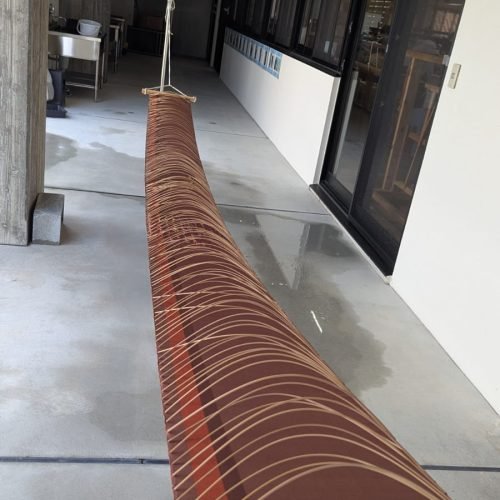Nanditha Nair is the 2024 Individual fellowship and Grant Awardee in Crafts of Asian Cultural Council. Nanditha’s project is to document the Okinawan weaving traditions along with her collaborators Ajilal V.C. and Phanuwit {Rico} Kanthatham. The project aims to create a documentary video, showcasing people, patterns, methods, and materials of Okinawan weaving, emphasizing the rhythmic body movements integral to Okinawan weaving.
Nanditha’s Individual Fellowship activities centre around the exploration and documentation of the traditional weaving techniques in Okinawa, with a particular focus on the materials used in the process. She will delve into the intricate art of weaving, emphasizing three specific types: Kijoka Bashofu, Yomitanzan Hanaori, and Shuri Ori. Additionally, she plans to explore the unique dyeing technique known as Ryukyu Bingata. She aims to collaborate with local artisans, weavers, and cultural experts in Okinawa who have inherited and continue to practice these traditional crafts.
Where: The activities will primarily take place in Okinawa, Japan, specifically in locations known for their rich weaving traditions. This includes visits to weaving workshops, cultural centers, and interaction with local communities to gain a comprehensive understanding of the cultural significance of these crafts.
Why: The purpose of this fellowship is multifaceted. Nanditha aims to contribute to the preservation and documentation of the rich cultural heritage, specifically focusing on traditional weaving techniques. Additionally, she hopes to foster cultural exchange by learning from local artisans and sharing my experiences with a wider audience. By understanding the cultural context, she aims to bridge the gap between traditional craftsmanship and contemporary perspectives.
How: The methodology involves a combination of hands-on learning, observation, interviews with local artisans, and documentation through various media such as photography and videography.
The Outcome: Through this fellowship, Nanditha hope to gain a deep understanding of the traditional weaving techniques of Okinawa, not just from a technical standpoint but also from a cultural and historical perspective. She aspires to learn the nuanced details of the rhythmic body movements involved in weaving, recognizing the cultural symbolism embedded in the patterns, and understanding the cultural evolution of these crafts. Moreover, she aims to develop cross-cultural communication skills by engaging with local artisans and the community, fostering mutual understanding and appreciation. In conclusion, this fellowship is not only an exploration of traditional crafts but also a journey into the heart of Okinawa’s cultural identity. By immersing herself in the weaving traditions and engaging with the local community, Nanditha hopes to contribute to the preservation of these crafts while fostering meaningful cultural exchange. The documentary is set to be featured at prominent documentary, literary, and textile festivals across the UK, US, and India.

